
Coe Memorial Park is located in Torrington, Connecticut.

Coe Memorial Park is located in Torrington, Connecticut.
Torrington’s original town common was in what is now a rural area off University Drive; no evidence of it remains. Today, Coe Memorial Park, located just south of the Naugatuck River, functions as the town green. It was given to the Town of Torrington on November 6, 1906, by Adelaide E. Coe Godfrey, Edward Turner Coe, and Ella Seymour Coe, as a memorial to their parents, Lyman Wetmore Coe, President of Coe Brass Company, and his wife, Eliza Seymour Coe, whose home had been on the property. The donation was made with several stipulations including that (1) a street, known as Elm Street, near the rear of the property be removed and abandoned, (2) the Coe’s home and outbuildings be removed; (3) Mrs. Coe’s large, Victorian greenhouse be removed, and (4) a monument be erected acknowledging the gift and its benefactors. These were unfortunate losses, but it gave the town a green or park at the fringe of the center. Additional parcels were later added to the Park and today, it covers about five acres.
Coe Memorial Park was designed by James W. Scott in 1907 or 1908. Scott is also responsible for Keney Park in Hartford. Percival Gallagher of the Olmsted Brothers firm in Boston had been retained by the town selectmen to prepare drawings for the Park in 1907. These drawings were completed, but not executed even though a number of later town records credit Mr. Gallagher with the design. Shortly after, the Park was completed according to Mr. Scott’s plan.

A great drama was made of the selection of a boulder upon which to place the memorial plaque for the Coes. The selected boulder weighed 15 tons and was moved through the center of town to the Park on the logging wagon pulled by twenty horses. The Civil War monument was originally erected in front of Town Hall in 1879 and was moved to Coe Memorial Park in 1936.
The Coe Memorial Park Civic Center was built in 1973 on the Park to provide a civic meeting center and offices for the town recreation department much to the dismay of the descendants. A monumental stone sculpture fountain designed by Massachusetts’ artist Edward Monti (who in 2004 worked on a Holmstead-planned public art installation in Quincy, Massachusetts's Merrymount Park) was erected in the Park in 1981 and dedicated to all Veterans of the Vietnam War era. A plan for revitalization of the Park was proposed in 1983, (with the misinformation that the Olmsted Brothers had originally designed the Park); portions of the plan have been executed.
In 1997, the Coe Memorial Park Subcommittee was established by then-Mayor Mary Jane Gryniuk to oversee the management of the Park.
Located on the previous site of the Coe’s grand Victorian home, the Park was created as a living memorial to the Coes by their children, Edward Turner Coe, Adelaide Eliza Coe Godfrey, and Ella Seymour Coe. Adelaide's husband, William H. K. Godfrey, was also one of the property's owners. Over the years, it has taken on the role of a New England town green for those who live in Torrington. It serves a commemorative function as well as providing a gathering place in the heart of the town to celebrate holidays and other events. It offers a welcome refuge in an otherwise densely developed area.
Coe Memorial Park is the beneficiary of a Trust established in 1922 by Adelaide Coe Godfrey, one of the Park’s original donors. The Trust solely provides the funds necessary for the care, maintenance, and improvement of Coe Memorial Park.
Beginning in 2001, the Coe Memorial Park Subcommittee has been working with Ferrero Hixon Associates and the City of Torrington on the Coe Memorial Park Master Plan. These plans were undertaken to complete the historical restoration of the Park grounds. With the assistance of Still River Gardens, LLC, it has become a botanical horticultural oasis in the heart of an urban downtown.
Phase I of the Coe Memorial Park Master Plan for the historic restoration was completed in 2005, re-sculpting the walkways and installing the gardens. Phase II is being developed and construction should begin in the near future. Phase III will address the restoration of the Carriage House which is the sole remnant of Alice Alvord's home and property.
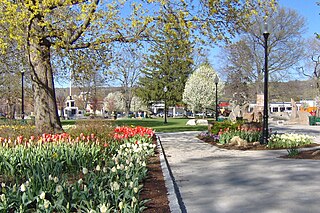
Torrington is the most populated municipality and largest city in Litchfield County, Connecticut, United States, and the Northwest Hills Planning Region. It is also the core city of Greater Torrington, one of the largest micropolitan areas in the United States. The city population was 35,515 according to the 2020 census. The city is located roughly 23 miles (37 km) west of Hartford, 34 miles (55 km) southwest of Springfield, Massachusetts, 67 miles (108 km) southeast of Albany, New York, 84 miles (135 km) northeast of New York City, and 127 miles (204 km) west of Boston, Massachusetts.

Queen's Park is an urban park in Downtown Toronto, Ontario, Canada. Opened in 1860 by Edward, Prince of Wales, it was named in honour of Queen Victoria. The park is the site of the Ontario Legislative Building, which houses the Legislative Assembly of Ontario. The phrase "Queen's Park" is regularly used as a metonym for the Government of Ontario or the Legislative Assembly of Ontario.
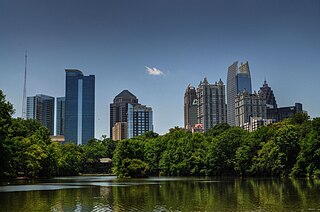
Piedmont Park is an urban park in Atlanta, Georgia, located about 1 mile (1.6 km) northeast of Downtown, between the Midtown and Virginia Highland neighborhoods. Originally the land was owned by Dr. Benjamin Walker, who used it as his out-of-town gentleman's farm and residence. He sold the land in 1887 to the Gentlemen's Driving Club, who wanted to establish an exclusive club and racing ground for horse enthusiasts. The Driving Club entered an agreement with the Piedmont Exposition Company, headed by prominent Atlantan Charles A. Collier, to use the land for fairs and expositions and later gave the park its name.

The Back Bay Fens, often called The Fens, is a parkland and urban wild in Boston, Massachusetts, in the United States. It was established in 1879. Designed by Frederick Law Olmsted to serve as a link in the Emerald Necklace park system, the Fens gives its name to the Fenway-Kenmore neighborhood.

The Emerald Necklace consists of a 1,100-acre chain of parks linked by parkways and waterways in Boston and Brookline, Massachusetts. It was designed by landscape architect Frederick Law Olmsted, and gets its name from the way the planned chain appears to hang from the "neck" of the Boston peninsula. In 1989, the Emerald Necklace was designated as a Boston Landmark by the Boston Landmarks Commission.
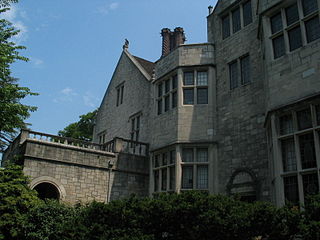
Planting Fields Arboretum State Historic Park, which includes the Coe Hall Historic House Museum, is an arboretum and state park covering over 400 acres (160 ha) located in the village of Upper Brookville in the town of Oyster Bay, New York.

Route 8 is a 67.36-mile (108.41 km) state highway in Connecticut that runs north–south from Bridgeport, through Waterbury, all the way to the Massachusetts state line where it continues as Massachusetts Route 8. Most of the highway is a four-lane freeway but the northernmost 8.8 miles (14.2 km) is a two-lane surface road.
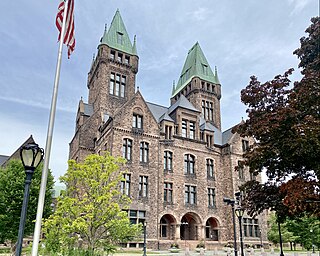
The Richardson Olmsted Complex in Buffalo, New York, United States, was designated a National Historic Landmark in 1986. The site was designed by the American architect Henry Hobson Richardson in concert with the landscape team of Frederick Law Olmsted, landscape architect of New York City's Central Park, and Calvert Vaux in the late 1800s, incorporating a system of treatment for people with mental illness developed by Thomas Story Kirkbride. Over the years, as mental health treatment changed and resources were diverted, the buildings and grounds began a slow deterioration. In 2006, the Richardson Center Corporation was formed to restore the buildings. The building was renovated and opened in 2023 at The Richardson Hotel.

Castle Hill is a 56,881 sq ft (5,284.4 m2) mansion in Ipswich, Massachusetts, which was completed in 1928 as a summer home for Mr. and Mrs. Richard Teller Crane, Jr. It is also the name of the 165-acre (67 ha) drumlin surrounded by sea and salt marsh that the home was built atop. Both are part of the 2,100-acre (850 ha) Crane Estate, located on Argilla Road. The estate includes the historic mansion, 21 outbuildings, and landscapes overlooking Ipswich Bay on the seacoast off Route 1, north of Boston. Its name derives from a promontory in Ipswich, Suffolk, England, from which many early Massachusetts Bay Colony settlers immigrated.

Weston Park is a public park with an area of just over 5 hectares in the City of Sheffield, South Yorkshire, England. It lies immediately west of the City Centre, alongside the Weston Park Museum. It is situated next to the University of Sheffield Library, Geography and Firth Court buildings, and across the road from Sheffield Children's Hospital. Along with Crookes Valley Park and The Ponderosa it is one of the three Crookesmoor parks.

Oldfields, also known as Lilly House and Gardens, is a 26-acre (11 ha) historic estate and house museum at Newfields in Indianapolis, Indiana, United States. The estate, an example of the American country house movement of the late nineteenth and early twentieth centuries, was designated a U.S. National Historic Landmark in 2003.

The Central Park Mall is a pedestrian esplanade in Central Park, in Manhattan, New York City. The mall, leading to Bethesda Fountain, provides the only purely formal feature in the naturalistic original plan of Frederick Law Olmsted and Calvert Vaux for Central Park.

The Muddy River is a series of brooks and ponds that runs through sections of Boston's Emerald Necklace, including along the south boundary of Brookline, Massachusetts. The river, which is narrower than most waterways designated as rivers in the United States, is a protected public recreation area surrounded by parks and hiking trails, managed by the Massachusetts Department of Conservation and Recreation.

The Downtown Torrington Historic District encompasses the historic central downtown area of Torrington, Connecticut. Centered on a crossing of the Naugatuck River, the 56-acre (23 ha) historic district is well-represented with architecture from the mid-19th to early 20th centuries. It was listed on the National Register of Historic Places in 1988.

Pulaski Park is a city park along the Connecticut River in Holyoke, Massachusetts. Originally called Prospect Park when it was laid out in 1884, it was given its present name in 1939 in honor of American Revolutionary War hero Casimir Pulaski, for whom there is a memorial in the park's center. The original 5.1-acre (2.1 ha) park was designed by the Olmsted Brothers landscape design firm.
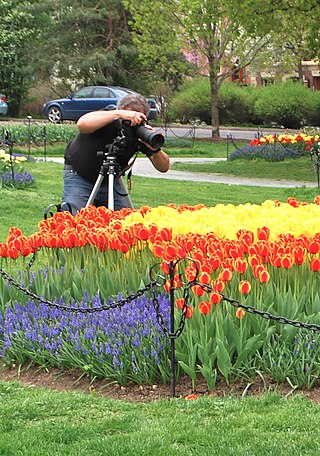
Washington Park in Albany, New York is the city's premier park and the site of many festivals and gatherings. As public property it dates back to the city charter in 1686, and has seen many uses including that of gunpowder storage, square/parade grounds, and cemetery. The park is often mistaken as being designed by Frederick Law Olmsted, as it incorporate many of the philosophical ideals used by Olmsted when he designed Central Park in Manhattan. The park is about 81 acres (33 ha) in size with the 5.2-acre (2.1 ha) Washington Park Lake, a roughly 1,600-foot-long (490 m) and 140-foot-wide (43 m) lake, in the southwestern corner.
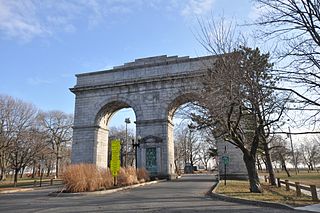
Seaside Park, located in Bridgeport, Connecticut, is a 2.5-mile (4.0 km) long crescent-shaped park bordering Bridgeport Harbor, Long Island Sound, and Black Rock Harbor. The park lies within Bridgeport's South End neighborhood.

The Rahway River Parkway is a greenway of parkland along the banks the main stem Rahway River and its tributaries in Union County, New Jersey, United States. Created in the 1920s, it was one of the inaugural projects of the newly-created Union County Parks Commission. It was designed by the Olmsted Brothers firm, sons of landscape architect Frederick Law Olmsted. The Rahway River Greenway plan expands on the original design. Many of the crossings of the river are late 19th century or early 20th century bridges. The East Coast Greenway uses paths and roads along the parkway.

The Dairy is a small building in Central Park in Manhattan, New York City, designed by the architect Calvert Vaux. The building was completed in 1871 as a restaurant but is now one of the park's five visitor centers managed by the Central Park Conservancy, and also contains a gift shop. The Dairy is located in the southern section of Central Park just south of the 65th Street transverse road. Adjacent features include the Central Park Carousel and the Heckscher Playground and Ballfields to the west, Sheep Meadow to the northwest, Central Park Mall to the north, Central Park Zoo to the east, The Pond and Hallett Nature Sanctuary to the southeast, and Wollman Rink to the south.

The Concert Grove is a section of Prospect Park, Brooklyn, New York City, that historically functioned as an outdoor music venue. It still serves as a sculpture garden lined with busts of musical figures, largely put up by German American Sängerfest participants and other cultural groups. The Concert Grove also includes the Concert Grove Pavilion, formerly known as the Oriental Pavilion, and adjoins a Lincoln sculpture facing the lake.